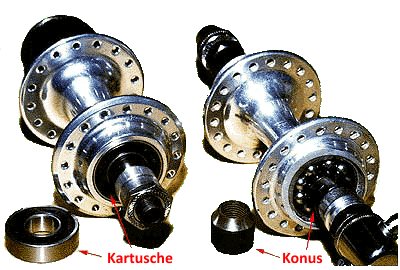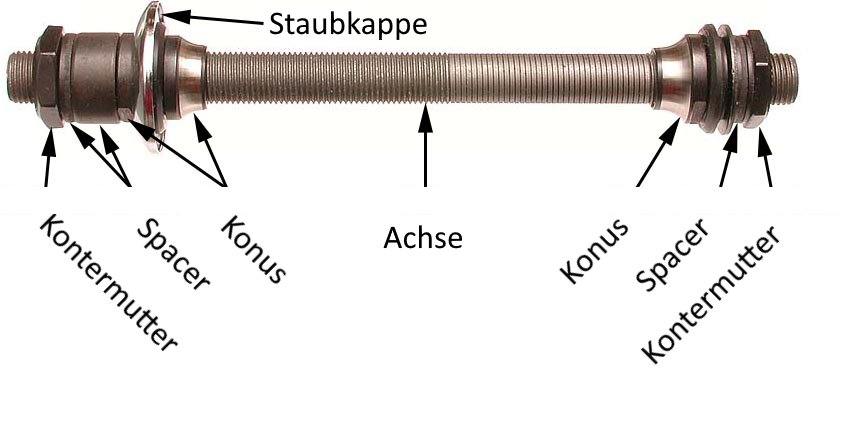Konenzentrierung
Eine überwiegende Mehrheit der Fahrräder hatte einen Nabentyp, der einen Lageraufbau mit Konus und Kugellagern hatte (s. Bild unten). Dieser Nabentyp kann leicht gewartet werden, muss jedoch gründlich justiert werden, um Reibung zu minimieren und die Lebensdauer zu verlängern. Die Lagerschalen sind in den Nabenkörper eingebaut. Die Konen sind konische Muttern, die auf die Achse geschraubt werden. Stahlkugeln rollen zwischen Lagerschale und Konus. Die Kombination von Lagerschale, Konus und Kugeln bildet das Lager. Diese Lager gibt es auf beiden Seite der Nabe.
Wenn man die Konen zu stark anschraubt, wird zu viel Kraft auf die Lagerkugeln ausgeübt. Das erzeugt sehr hohe Reibung und das Laufrad wird sich nicht richtig frei drehen. Der Verschleiß wird die Lebensdauer stark reduzieren.
Wenn man die Konen nicht stark genug anschraubt, haben die Lager Spiel. Das Laufrad kann im Lager hin- und herwackeln. Das ist sehr unerfreulich und erzeugt Kontrollverlustprobleme.
Daher ist die Einstellung dieser Lager kritisch. Korrekturen im Bereich einer 1/10 Umdrehung oder weniger sind notwendig, um die richtige Einstellung zu erreichen.
Die meisten Konuslager habn dünner Kontermuttern, um die Konen an Ort und Stelle zu halten. Konnen und Kontermuttern werden gegeneinander angezogen (meist mit Spacern dazwischen). Das hält den Konus davon ab, sich von der Einstellposition zu lösen. Folgende Varianten existieren:
- Manche ältere englische Fahhräder haben ein anderes System.
- Bei Nabenschaltungen wird der linke Konus gelöst und der rechte sorgt für die EInstellung des Innenlebens (das variierte jedoch stark zwischen Marken und Modellen), danach wird r linke Konus wieder angezogen.
Klassische Vollachsennaben werden mit Muttern am Ausfallende der Gabel bzw. des Rahmens befestigt und müssen fest genug eingestellt werden, damit Spiel seitwärts minimiert wird aber lose genug, damit sich das Laufrad frei bewegen kann.
Schnellspannernabeneinstellung
Naben mit Schnellspanner sind etwas schwieriger einzustellen, weil der Schnellspannermechanismus die Achse leicht komprimiert, wenn er festgezogen wird. Wenn man die Konen so einstellt, dass sie sich vom Fahrrad entfernt richtig anfühlen, werden sie blockieren, sobald man die Nabe ins Rad einbaut und einspannt. Man muss die Konen so einstellen, dass sie ein wenig Spiel haben, solange sie außerhalb des Fahrrads sind oder mit fast ganz geöffnetem Schnellspanner im Ausfallende stecken.
Many people undertighten quick release skewers. You can sort of get away with this, because most newer bikes have vertical dropouts in the rear, so the wheel won't slip forward under load. In the front, we have the execrable "lawyer lips" to defeat the purpose of the quick release. While lawyer lips will prevent a wheel from coming off it the quick release is loose, they don't prevent a loose wheel from wobbling, and they don't provide any protection at all if the skewer breaks.
To check your bearing adjustment, put the wheel into the bike with the quick release just barely tight enough to keep the wheel from falling out. If you are working on the rear wheel, take it out and re-install it so that the chain is not engaging the sprockets.
Try to wiggle the rim back-and-forth between the brake shoes; since the QR isn't tight, there should be a bit of play. If there is, hold the tire so that the valve is at the 3:00 or 9:00 position, then let go of it. On most wheels, the valve is the heaviest part; on wheels that have spoke reflectors, the reflector will be the heaviest part. Whatever is the heaviest part of the wheel, it should cause the wheel to turn and swing back and orth like a pendulum, before finally coming to a stop.
Once you have seen how the wheel turns with the quick release loose, try tightening the QR, then check again. If your bearing adjustment is correct, the play will disappear, but the wheel will turn as freely as it did when it was too loose. For very fine tuning of this, you can slightly vary the adjustment of the quick-release skewer, as long as it is good and snug.
Some high-performance wheels have a seam filler in the rim that weighs almost as much as the valve, so you may have to clip a clothespin or spoke wrench onto the wheel to artificially make a heavy spot. This may also be needed on wheels that have hubs with rubber contact seals, like many newer mountain-bike hubs.
This is not an issue in non-adjustable cartridge bearing hubs, such as Phil Wood. Adjustable cartridge bearing hubs should be adjusted under load -- easier on some than others.
Konusschlüssel
The flats that let you turn the cones are usually quite shallow, so you will need at least one, preferably two special cone wrenches. Most front hubs require 13 mm cone wrenches, most rears take 15 mm. For most cyclists, the best choice is to buy double-ended cone wrenches with a 13 mm end and a 15 mm end. Park and Wheels Inc. make very good quality double-ended cone wrenches. Cycle Pro and Bicycle Research brands are good for the home mechanic on a budget.
For shop use, single-ended cone wrenches with padded handles are more pleasant to work with. The current (laser cut) Park shop wrenches are quite good. I was not too pleased with the older stamped Park cone wrenches (shiny chrome finish).
Cone wrenches are very thin for their size, and should not be used for anything other than cones. Even when used properly, these are basically consumable tools, not a "lifetime investment" as with other wrenches from reputable manufacturers. My major hub tools are a pair of laser-cut 13 and 15 cone wrenches, which fit the vast majority of hubs, and a pair of 17 mm combination wrenches. To loosen a front hub, I put a 13 mm on each cone and back them apart, simultaneously tightening them against the locknuts. To tighten the hub, I use the two 17 mm wrenches on the locknuts. I rarely have to loosen the locknuts. This procedure is very fast, which is a good thing, considering how large a percentage of bikes have too-tight cones.
The same approach works for conventional rear hubs if the freewheel is off.
For cassette hubs, or conventional rear hubs that I want to adjust without removing the freewheel, I use a thin 15 mm wrench and the two 17's.
To loosen this type of hub, I usually do have to loosen the left locknut from its cone, loosen the cone, then re-tighten the locknut. To tighten it, the two 17's on the locknuts do the job quickly and easily.
Spezielles Werkzeug zur schnellen Einstellung von Konuslagern unter Last
I have made a special tool for cone adjustment on QR hubs, consisting of a skewer and a spacer bushing to allow the handle end of the skewer to press against the end of the axle, leaving the locknuts unobstructed. This is very handy, and saves a good deal of time in the shop. Since it presses directly on the ends of the axle, you can make the actual adjustments while the axle is under compressive load from the quick release. This has not previously been possible.
The spacer bushing consists of an old, worn-out cone, with a short length of axle screwed into it, so it fits reasonably snugly onto the skewer. The quick-release body presses on this old cone; the stub of axle (which you can't see, because it is entirely inside the old cone) presses on the end of the axle. This tool is also useful for truing wheels if you use a truing stand, such as the Park, that doesn't compress the axle. This tool can remove the play from the bearings, and still allow you to install the wheel into the truing stand.
Naben mit Vollachse
Many low-end bikes come with solid-axle (non-quick-release) rear hubs. The quick procedure for these is to adjust them in the bike. I start by making sure that the right axle nut is really tight, then loosen the left axle nut and go in with my 15 & 17.
The quick check for rear bearings is to slowly backpedal with the bike off the ground. Depending on the degree of freeness of the freewheel, a properly adjusted wheel will either "pendulum" as a front wheel does, or, if the freewheel is a bit gooey, the wheel will turn backwards. If the wheel just sits there, the bearings are too tight (or the brake is rubbing!)
Wichtig
Poor cone adjustment is not usually obvious to a customer, but it is really quite important. If a hub is too tight, the bearing surfaces will self destruct prematurely, and the bike will not roll as freely as it should. Spoke Divider My Tool Tips series contains an older, more detailed article on selecting and using Cone Wrenches and another more general article on Hub Overhaul.
Quelle
Dieser Artikel basiert auf dem Artikel https://www.sheldonbrown.com/cone-adjustment.html Cone Adjustment Tool Tips Cotterless Cranks] von der Website Sheldon Browns. Originalautor des Artikels ist Sheldon Brown.
- Sattelstützenmaße
- Knarzen, Knacken und Quietschen
- Ritzelabstände (Tabelle)
- Auswechselbarkeit von Vierkant-Kurbelaufnahmesystemen bei Innenlagern
- Kettenlinienstandards (Tabelle)
- Ein bequemer Sattel
- Nabenbreiten (Tabelle)
- Alles über Nabenschaltungen
- Shimano Nexus und Alfine Acht-Gang-Naben
- Reifengrößen

